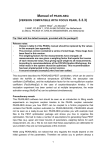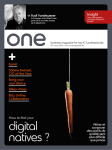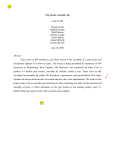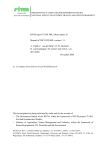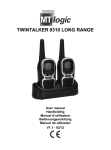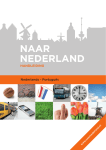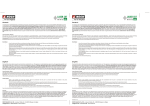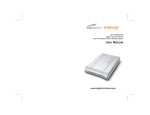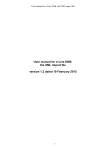Download View now
Transcript
Werkdocument 71 groen.qxp 25-09-2007 11:53 Pagina 1 WOt J. J. T. I. Boesten A. Tiktak R. C. van Leerdam Wettelijke Onderzoekstaken Natuur & Milieu Manual of PEARLNEQ v4 werkdocumenten 71 Manual of PEARLNEQ v4 J. J. T. I. Boesten A. Tiktak R. C. van Leerdam Werkdocument 71 Wettelijke Onderzoekstaken Natuur & Milieu Wageningen, september 2007 The ‘Working Documents’ series presents interim results of research commissioned by the Statutory Research Tasks Unit for Nature & the Environment (WOT Natuur & Milieu) from various external agencies. The series is intended as an internal channel of communication and is not being distributed outside the WOT Unit. The content of this document is mainly intended as a reference for other researchers engaged in projects commissioned by the Unit. As soon as final research results become available, these are published through other channels. The present series includes documents reporting research findings as well as documents relating to research management issues. This Working document was produced in accordance with the Quality Manual of the Statutory Research Tasks for Nature and the Environment Unit. (Dit werkdocument is gemaakt conform het Kwaliteitshandboek van de WOT Natuur & Milieu.) ©2007 Alterra P.O. Box 47, 6700 AA Wageningen. Tel: (0317) 47 47 00; fax: (0317) 41 90 00; e-mail: [email protected] Milieu- en Natuurplanbureau (MNP) P.O. Box 303, 3720 AH Bilthoven Tel: (030) 274 27 45; fax: (030) 274 44 79; e-mail: [email protected] The Working Documents series is published by the Statutory Research Tasks Unit for Nature & the Environment (WOT Natuur & Milieu), part of Wageningen UR. This document is available from the secretary’s office, and can be downloaded from www.wotnatuurenmilieu.wur.nl. Wettelijke Onderzoekstaken Natuur & Milieu (Statutory Research Tasks Unit for Nature & the Environment P.O. Box 47, 6700 AA Wageningen Tel: (0317) 47 78 44; Fax: (0317) 42 49 88; e-mail: [email protected]; Internet: www.wotnatuurenmilieu.wur.nl F-00082(2007) Project WOT-04-003-5233523-01 [Werkdocument 71 − September 2007 WOt-werkdocument 71 Contents Summary 5 1 Introduction 7 2 Precautionary remark 8 3 Description of the incubation experiment 9 4 Theoretical background 10 5 Fitting procedure for parameters with PEST 13 6 Installation of PEARLNEQ 14 7 Running the example 15 8 Run PEARL_Neq with your own data 17 9 Concluding remark 19 Literature 20 Appendix 1 Example input file 21 Appendix 2 Results of the default example 23 Appendix 3 Comparison between an analytical solution and PearlNeq 25 Appendix 4 Listing of Fortran program PearlNeq 27 Summary This manual describes the PEARLNEQ v4 sofware package . This package can estimate longterm sorption parameters using results of aged-sorption studies with soil. using a submodel for sorption and transformation that is identical to the submodel used for that purpose in the FOCUS_PEARL v3.3.3. The submodel assumes two types of sorption sites: equilibrium sites and non-equilibrium sites. The sorption isotherms for bot sites are described with Freundlich equations. The content sorbed at the equilibrium site is assumed to be continuously at equilibrium and the content sorbed at the non-equilibrium site is described with a pseudo first-order sorption rate equation. The transformation rate in soil is assumed to be proportional to the amount in the liquid phase plus the amount sorbed at the equilibrium site. So the content sorbed at the non-equilibrium site is not subject to transformation. The mathematical equations describing the submodel are solved via a FORTRAN programme. An additional FORTRAN programme generates the necessary input files for the PEST optimisation package. Instructions are given how to obtain optimized parameters using an example dataset and, subsequently instructions are given how to obtain parameters using your own data. Manual of PEARLNEQ v4 5 1 Introduction This document describes a PEARLNEQ-PEST combination, which can be used to estimate the parameters for long-term sorption kinetics in the PEARL model on the basis of an incubation experiment for a certain soil and a certain pesticide. The combination provides also the transformation half-life at reference temperature (when long-term sorption kinetics are included in PEARL, the definition of this half-life changes so it has to be recalculated; see Boesten and van der Linden, 2001). If the incubation experiment has been carried out at multiple temperatures, the Arrhenius activation energy for the transformation rate in soil can be optimised simultaneously. Manual of PEARLNEQ v4 7 2 Precautionary remark This PEARLNEQ-PEST software tool should be seen as an introduction to fitting results of experiments on long-term sorption kinetics to the sorption submodel used in the PEARL model. The tool shows you how PEST can be coupled to a fortran programme that contains this PEARL sorption submodel (i.e. PEARLNEQ.EXE) but it should not be seen as a ready-to-use tool. The tool provides you with example input files for the PEST optimisation package and shows you how to organise this optimisation. We had to make a number of assumptions for generating these PEST input files (e.g. upper and lower bounds of parameters, weighing factors for each measurement, etc. etc.). We do not claim that these assumptions are defensible for your problem; they are our best guesses but they may not be appropriate for your problem. It is your responsibility to check the appropriateness of the result obtained. We do not accept any responsibility for use of PEARLNEQ. 8 WOt-werkdocument 71 3 Description of the incubation experiment The PEARLNEQ-PEST tool can be used to fit the results of the following experiment. A number of jars is filled with soil. Each jar contains the same mass of moist soil. At the start of the experiment the same initial mass of pesticide is added to the moist soil in all jars. The jars are incubated at a fixed temperature (or at a few temperatures). At certain time points the remaining total amount of pesticide is measured via an extraction with organic solvent. At the same time the concentration in the liquid phase of the moist soil is measured. The liquid phase can be collected by centrifuging the moist soil over a filter. As an alternative for centrifuging, a desorption experiment can be carried out by adding a certain volume of water and subsequent shaking for about 24 h. It is assumed that additionally an adsorption isotherm with an equilibration time of about 24 h has been measured for the same soil and pesticide. Manual of PEARLNEQ v4 9 4 Theoretical background PEARLNEQ assumes a Freundlich two-site sorption submodel: one site for equilibrium sorption and the second site for long-term sorption kinetics. The operational definition for the equilibrium sorption sites is that they have reached equilibrium after about 24 h shaking of a well-stirred suspension of the soil in water. The long-term sorption sites do not reach equilibrium within 24 h. PEARLNEQ assumes first order degradation kinetics for the molecules present in liquid phase and sorbed to the equilibrium site; however, molecules sorbed on the kinetic site are assumed not to degrade. This conceptual model is presented in Figure 1. The submodel for sorption and degradation kinetics used in PEARLNEQ can be described as follows (Leistra et al., 2001): M p = V c L + M s ( X EQ + X NE ) X EQ ⎛ c ⎞ = K F , EQ cL , R ⎜⎜ L ⎟⎟ ⎝ cL , R ⎠ (1) N (2) N ⎛ c ⎞ dX NE = kd ( K F , NE cL , R ⎜⎜ L ⎟⎟ − X NE ) dt ⎝ cL , R ⎠ (3) K F , NE = f NE K F , EQ (4) dM p dt = −k t (V c L + M s X EQ ) KF,EQ = mOM KOM,EQ (5) (6) where: Mp = initial total mass of pesticide in each jar (μg), acronym MasIni V = the volume of water in the soil incubated in each jar (mL), acronym VolLiq Ms = the mass of dry soil incubated in each jar (g), acronym MasSol cL = concentration in the liquid phase (μg/L), acronym ConLiq cL,R = reference concentration in the liquid phase (μg/L), acronym ConLiqRef XEQ = content sorbed at equilibrium sites (μg/g) XNE = content sorbed at non-equilibrium sites (μg/g) KF,EQ = equilibrium Freundlich sorption coefficient (mL/g), acronym CofFreEql KF,NE = non-equilibrium Freundlich sorption coefficient (mL/g), acronym CofFreNeq N = Freundlich exponent (-),acronym ExpFre kd = desorption rate coefficient (d-1), acronym CofRatDes fNE = a factor for describing the ratio between the equilibrium and non-equilibrium Freundlich coefficients (-), acronym FacSorNeqEql kt = degradation rate coefficient (d-1) mOM = mass fraction of organic matter in the soil (kg/kg), acronym CntOm KOM,EQ = coefficient of equilibrium sorption on organic matter (mL/g), acronym KomEql 10 WOt-werkdocument 71 PEARLNEQ does not use the transformation rate coefficient (kt) as input parameter, but the half-life at reference temperature (acronym DT50Ref, dt50). They are related as follows (assuming first order kinetics): dt50 = ln (2) / kt (7) The effect of soil temperature on the transformation rate coefficient in soil is described by the Arrhenius equation: ⎛−E ⎡1 1 ⎤ ⎞⎟ f T = exp⎜⎜ ⎢ − ⎥⎟ ⎝ R ⎣ T TREF ⎦ ⎠ (8) where fT = the multiplication factor for the rate coefficient (-) E = Arrhenius activation energy (kJ/mol) T = temperature of the soil (K) TREF = the reference temperature for the specified DT50 (K) R = the gas constant (kJ mol-1 K-1 ). Figure 1. Conceptual representation of the PEARLNEQ model. Often no concentration measurements in the soil pore water are available but instead at each sampling point in time a certain volume of water (usually a CaCl2 solution) is added to soil and the suspension is shaken for about 24 h after which the concentration in the supernatant is measured. In such a case the fit has to be based on these concentration measurements in the supernatant of the soil-water suspension. This is simulated in PEARLNEQ as follows: (A) it is assumed that full equilibrium is reached for the equilibrium sorption site during the desorption experiment (i.e., shaking for 24 h) (B) it is assumed that desorption from the non-equilibrium sorption site can be ignored during the desorption experiment. Manual of PEARLNEQ v4 11 Assumption A is justifiable because this is exactly the operational definition of the equilibrium sorption site. Assumption B is justifiable because desorption coefficients for long-term kinetics are usually in the order of 0.01 d-1, which implies that amounts desorbed within 1 day are negligibly small. Using these assumptions, the concentration in the liquid phase of the supernatant after desorption can be estimated by stating that (i) the total content of substance in the moist soil and the soil-water suspension have to be equal, and (ii) the content sorbed at the nonequilibrium sites in the moist soil and in the soil-water suspension are equal. Using Equation 1 then results in the following equation V c L , MS + M s (X EQ , MS + X NE ) = (V + V ADD ) c L , SUS + M s (X EQ , SUS + X NE ) (9) where: the subscript MS indicates the moist-soil system the subscript SUS indicates the soil-water suspension system and VADD = volume of liquid (usually CaCl2 solution) added to the soil at each sampling point just before starting the 24 h desorption experiment (mL), acronym VolLiqAdd. At each sampling point in time, Equation 9 can be rewritten (using Eqn 2) into an equation that contains only one unknown variable, i.e. the concentration in the liquid phase of the soil suspension (cL,SUS). PEARLNEQ provides as output always the concentration in the soil-water suspension as a function of time. If VADD = 0, then this implies that the concentration in the moist soil is given. PEARLNEQ solves the set of Eqn 1 to Eqn 9 numerically using Euler’s method for integration of the state variables Mp and XNE. The time step for integration can be set as an input parameter (we recommend 0.01 d). The concentration in the liquid phase is calculated via an iteration procedure as described in Appendix 4 of FOCUS (2006). Appendix 3 shows a test of the PEARLNEQ results against an analytical solution for the case of a linear isotherm (N=1), indicating good correspondence between numerical and analytical results. 12 WOt-werkdocument 71 5 Fitting procedure for parameters with PEST The provided package assumes that the following variables need to be optimized: • the initial mass of the pesticide (MasIni) • the ratio between the equilibrium and non-equilibrium Freundlich coefficients (FacSorNeqEql) • the desorption rate coefficient (CofRatDes) • the half-life at reference temperature (DT50Ref) • the molar activation energy (MolEntTra); this can only be optimized if the experiment has been carried out at multiple temperatures. It is assumed that all other variables are known. The provided package assumes that the measurements that are fitted, consist for each point in time of • a mass of pesticide in μg • a concentration in liquid phase in μg/mL. PEST needs a number of input parameters for the fitting procedure (e.g. upper and lower bounds of parameters, weighing factor for each measurement, etc. etc.). Our experience is that the weighing factor for each measurement is the most important input parameter. Therefore we offer two options for weighing: ‘equal’ which gives a weight of 1.0 to all observations (so equal weights) ‘inverse’ which gives a weight that is proportional to the inverse of the observed value. If the observed value is zero, the weight is set equal to 1.0 in any case. The option ‘equal’ implies that high observed values get more weight than low observed values. As described above, the fitting procedure considers two quantities: mass of pesticide and the concentration in the liquid phase. This may lead to completely different weights for these two types of quantities. E.g. if the mass is initially 50 μg and the concentration in the liquid phase is in the order of 1 μg/mL, then the fitting procedure will be completely dominated by the decline of the mass of pesticide. So if the option ‘equal’ is used, the user should choose a mass of solid phase such that the values of the mass of pesticide in μg should be in the same order of magnitude as the concentration in liquid phase in μg/mL. The option ‘inverse’ implies that each measurement gets more or less equal weight for the parameter estimation. This ‘inverse’ option gave the best results in a few tests. However, we do not claim that this is the best choice for your dataset nor do we claim that the other PEST input parameters are the best choice for your dataset. The provided package cannot handle duplicate or triplicate observations for each point in time. Within PEST there are procedures available to do so but these have not yet been implemented in PEARLNEQ. So the user has to average first all measurements for each point in time. Manual of PEARLNEQ v4 13 6 Installation of PEARLNEQ PEARLNEQ is distributed in a zip file. Unzip the file and specify a path (e.g. c:\pearlneq). Be sure there is no space within the specified path, because this will cause of failure. The package contains four directories, i.e. Neq_Bin, Pest, Neq_fortran_source_files and Neq_Example. • The Neq_Bin directory contains the PEARLNEQ executables, PEARLNEQ.EXE and PEARLMK.EXE. • The PEST optimisation software is available in the Pest directory. As PEST is now available freeware (http://www.sspa.com/pest), we included the latest version as of 2910-2003 (version 7.0.1.). Separate installation of PEST is not necessary. • The Neq_fortran_source_files directory contains the fortran source files used to generated the PEST input files and the programme that calculates the sorption kinetics • The Neq_Example directory contains results from an example study, as described in the FOCUS PEARL user manual, version 1.1.1 § 3.2.10 (page 51-54). 14 WOt-werkdocument 71 7 Running the example The following steps must be followed. 1 Run the example, to check if everything works and get experience with the system. Go to the Neq_Example directory, and run the example, example.bat. • The batch file will first call PEARLMK. This pre-processing program generates the input files for PEST, i.e. example.pst, example.tpl and example.ins (see Figure 2, RunId = “example”) • Then, the optimisation starts. PEST calls PEARLNEQ several times (see Figure 2; in the example 39 times). • If you get an error message after the first step (PEARLMK), type control-break to stop the process and check the error messages available in the example.err file. 2 After successful optimisation, read the results from the file example.rec. Choose “select the program from the list” and open with Notepad. The relevant results, including parameter values, 95% confidence intervals and correlation matrices can be found at the end of this file (Section OPTIMISATION RESULTS, see Appendix 2). The meaning of the short acronyms in this rec-file is as follows: fsne = FacSorNeqEql crd = CofRatDes dt50 = DT50Ref masini = MasIni met = MolEntTra. PEST also generates parameter sensitivity files etc. Details can be found in the PEST manual, which is available in the PEST subdirectory of the package. 3 If you encounter errors during the second step, you can try running PEARLNEQ directly. PEARLMK has created a file example.neq (in …\Neq_Example) which is the input file for pearlneq. You can run PEARLNEQ by typing “..\Neq_Bin\pearlneq example” in a DOS-box. 4 PEARLNEQ will create an output file (example.out) and a log file (example.log). The output files are self-explaining. The output file contains the result of the last run which is in PEST by definition the run with the optimised parameters. 5 You can use the XyWin program to make a graph. (After running the example this will be done automatically.) XyWin is available in the neq_bin\xypearl directory of PEARLNEQ: you can also get the graph via typing in a DOS box: “..\Neq_Bin\xypearl\xywin –j example.job –W l”. However, XyWin is not userfriendly so we recommend to use the results from the output file (example.out) as the source for the best fit and create graphs with software of your own choice. Manual of PEARLNEQ v4 15 RunId.mkn PearlMk RunId.ins If Converged RunId.rec RunId.tpl RunId.pst Pest RunId.neq PearlNeq RunId.out Figure 2. Dataflow diagram for the “example” for the example provided. 16 PEARLNEQ-PEST combination. The acronym RunId is WOt-werkdocument 71 8 1 Run PEARL_Neq with your own data We assume that you have carried out an appropriate incubation experiment as described before. The first step of optimising your own data consists of editing the file example.mkn, which can be found in the example subdirectory of the PEARLNEQ directory. Open the file with Notepad. Please make a copy of this file before editing. Make sure there is no space in the new name. This will give an error. An example of this input file is listed in Appendix 1. The following parameters must be provided: ¾ TimEnd (d): The duration of the incubation experiment. ¾ MasSol (g): The mass of dry soil incubated in each jar. ¾ VolLiqSol (mL): Volume of liquid in the moist soil during incubation. ¾ VolLiqAdd (mL): Volume of liquid added to the soil after incubation (i.e. the amount of liquid added to perform a conventional desorption equilibrium experiment). ¾ CntOm (kg.kg-1): Mass fraction of organic matter in the soil. ¾ ConLiqRef (mg L-1): Reference concentration in the liquid phase. ¾ ExpFre (-): Freundlich exponent; use value taken from adsorption isotherm measured for this pesticide-soil combination ¾ KomEql (L kg-1): coefficient of equilibrium sorption on organic matter; use value taken from adsorption isotherm measured for this pesticide-soil combination; in case you have no organic matter content of the soil, set the organic matter to 1.0 and specify the measured Freundlich equilibrium coefficient (see Eqn 6) ¾ MasIni (μg): The initial total mass of pesticide in each jar. In contrast to initial versions of PEARLNEQ, this parameter will be optimised. There is no default value for this parameter. ¾ FacSorNeqEql (-): factor describing the ratio fNE = KF,NE/KF,EQ as defined by Eqn 4. This parameter will be optimised, but you have to specify an initial guess here. The default value is 0.5. ¾ CofRatDes (d-1): the desorption rate coefficient. This parameter will be optimised, but you have to specify an initial guess here. The default value is 0.01 d-1. ¾ DT50Ref (d): the transformation half-life under reference conditions, applying to the equilibrium domain. This parameter will be optimised, but you have to specify an initial guess here. As a default value, you can use the ‘classical’ half-life, which applies to the total soil system (i.e. the equilibrium domain + the non-equilibrium domain). ¾ TemRefTra (C): The reference temperature, for which the half-life will be provided (set to incubation temperature if data for only one temperature are available and set to 20o C if you have data for multiple temperatures). ¾ MolEntTra (kJ mol-1): the molar enthalpy of transformation. This parameter will be optimised if you have carried out the experiment at multiple temperatures; otherwise it is a model-input. In any case you have to specify a value (e.g. 60 kJ mol-1) which will be used as an initial guess in case of data for more than one temperature. ¾ table Tem (C): List of temperatures at which the incubation experiment has been carried out. One temperature is OK if only data for one temperature are available. ¾ table Observations: List of observations. The first column contains the time (d), the second column the temperature, column 3 contains the total mass of pesticide in the system (μg), column 4 contains the concentration of pesticide (μg mL-1) measured in the pore water of moist soil (then VolLiqAdd = 0) or in the water phase after a desorption experiment (in which case VolLiqAdd is not zero) and column 5 contains the characters ‘OBS’. Manual of PEARLNEQ v4 17 ¾ option Opt_weights: options for weights. Two options for weighing are offered: ‘equal’ which gives a weight of 1.0 to all observations (so equal weights) and ‘inverse’ which gives a weight that is proportional to the inverse of the observed value; if the observed value is zero, the weight is set equal to 1.0 in any case; you can inspect the weigths in the ‘pst’ file. 2. Modify the contents of the example.bat file (with right mouse button): replace “example” everywhere it occurs by the name of the copied input file and delete last line of the file (which would generate the graph). Repeat step 1-5 of chapter 7. 3. If the optimization is not succesfull, you can try re-running PEARLNEQ with different initial guesses of MasIni, DT50Ref, FacSorNeqEql and CofRatDes. 18 WOt-werkdocument 71 9 Concluding remark While using PEARLNEQ, we noticed that very regularly the results depend on the initial guesses of the parameters. Therefore we advise you to perform always a number of runs with different initial guesses. We advise you also to analyse the results very carefully, especially the 95% confidence intervals of your parameters. If the interval is wide for a certain parameter, this indicates that the estimated variable is very uncertain. As a consequence it is usually not meaningful to use it any further in the risk assessment. Manual of PEARLNEQ v4 19 Literature Boesten JJTI & AMA van der Linden (2001) Effect of long-term sorption kinetics on leaching as calculated with the PEARL model for FOCUS scenarios. BCPC Symposium Proceedings No. 78: Pesticide behaviour in soils and water, p. 27-32. FOCUS (2006). Guidance document on estimating persistence and degradation kinetics from environmental fate studies on pesticides in EU registration. EC Document Sanco/10058/2005 version 2.0, European Commission, Brussels, 434 pp. (Available at http://viso.ei.jrc.it/focus.) Leistra, M, AMA van der Linden, JJTI Boesten, A Tiktak & F van den Berg (2001). PEARL model for pesticide behaviour and emissions in soil-plant systems: description of the processes in FOCUS PEARL version 1.1.1. Alterra Report 013, Alterra, Wageningen. RIVM Report 711401009; RIVM Bilthoven. (Available at PEARL website to be found via Help-button in main screen of PEARL.) Tiktak A, F. van den Berg, JJTI Boesten, D van Kraalingen, M Leistra & AMA van der Linden, 2000. Manual of FOCUS PEARL version 1.1.1. RIVM report 711401008, RIVM Bilthoven, the Netherlands. (Available at PEARL website to be found via Help-button in main screen of PEARL.) 20 WOt-werkdocument 71 Appendix 1 Example input file Example input file “example.mkn” *----------------------------------------------------------------------------------------* STANDARD FILE for pearlmk version 4 * Program to fit the half-life, activation energy and parameters for long-term sorption * kinetics of pesticides in soil * * This file is intented for use with the PEST program (Doherty et al., 1991). * Please see manual of PEARLNEQ * * (c) RIVM/MNP/Alterra 2003, 2005, 2006, 2007 *----------------------------------------------------------------------------------------- * Model control Yes ScreenOutput 0.0 TimStart (d) Start time of experiment 500.0 TimEnd (d) End time of experiment 0.01 DelTim (d) Time step of Euler's integration procedure * System characterization 54.64 MasIni (ug) Initial guess of initial mass 45.36 MasSol (g) Mass of soil in incubation jar 6.64 VolLiqSol (mL) Volume of liquid in the moist soil 0.0 VolLiqAdd (mL) Volume of liquid ADDED 0.047 CntOm (kg.kg-1) Organic matter content * Sorption parameter 1.0 ConLiqRef (mg.L-1) Reference liquid concentration 0.87 ExpFre (-) Freundlich exponent 2.1 KomEql (L.kg-1) Coefficient for equilibrium sorption 0.5 FacSorNeqEql (-) Initial guess of ration KfNeq/KfEql 0.01 CofRatDes (d-1) Initial guess of desorption rate constant * Transformation parameters 14.00 DT50Ref (d) Initial guess of half-life at ref. temperature 20.0 TemRefTra (C) Reference temperature 110.0 MolEntTra (kJ.mol-1) Initial guess of molar activation energy * Temperature at which the incubation experiments have been carried out table Tem (C) 1 5.0 2 15.0 Manual of PEARLNEQ v4 21 end_table * Provide the results of the measurements * Tim Tem Mas ConLiq * (d) (C) (ug) (ug/mL) table Observations 2 5 51.6300 5.7285 OBS 10 5 50.5900 5.0560 OBS 42 5 46.0200 3.6635 OBS 87 5 38.6100 2.9320 OBS 157 5 32.8150 1.9280 OBS 244 5 25.8700 1.4650 OBS 358 5 20.3150 0.8820 OBS 451 5 9.4250 0.6015 OBS 2 15 51.3300 5.8955 OBS 6 15 47.3950 4.4425 OBS 10 15 45.0650 3.9510 OBS 42 15 23.1400 1.6470 OBS 87 15 10.8950 0.6710 OBS 157 15 3.1350 0.1525 OBS 244 15 1.4400 0.0305 OBS 358 15 0.4500 0.0000 OBS 451 15 0.1500 0.0000 OBS end_table * Option for weights of observations: *'equal' gives equal weights to all measurements *'inverse' gives weigth equal to inverse value of each measurement (if measurement is zero then weight is 1.0) inverse 22 Opt_weights WOt-werkdocument 71 Appendix 2 Results of the default example Results (taken from last section of REC-file) These are the results of the defaultexample, provided with the package. OPTIMISATION RESULTS Parameters -----> Parameter fsne crd dt50 masini met Estimated value 0.600286 1.226317E-02 13.0062 56.0664 108.755 95% percent confidence limits lower limit upper limit 0.408681 0.791892 9.886449E-03 1.463989E-02 11.5100 14.5024 52.1243 60.0084 102.806 114.705 Note: confidence limits provide only an indication of parameter uncertainty. They rely on a linearity assumption which may not extend as far in parameter space as the confidence limits themselves - see PEST manual. See file EXAMPLE.SEN for parameter sensitivities. Observations -----> Observation o1 o2 o3 o4 o5 o6 o7 o8 o9 o10 o11 o12 o13 o14 o15 o16 o17 o18 o19 o20 o21 o22 o23 o24 o25 o26 o27 o28 o29 o30 o31 o32 o33 o34 Measured value 51.6300 5.72850 50.5900 5.05600 46.0200 3.66350 38.6100 2.93200 32.8150 1.92800 25.8700 1.46500 20.3150 0.882000 9.42500 0.601500 51.3300 5.89550 47.3950 4.44250 45.0650 3.95100 23.1400 1.64700 10.8950 0.671000 3.13500 0.152500 1.44000 3.050000E-02 0.450000 0.00000 0.150000 0.00000 Manual of PEARLNEQ v4 Calculated value 55.5316 5.39742 53.4684 5.08081 46.2635 4.06320 38.2669 3.09390 29.0458 2.16483 20.9646 1.47675 13.8380 0.932184 9.90684 0.648450 53.3843 5.17830 48.4369 4.62304 43.9959 4.12910 21.3140 1.70735 8.98367 0.544736 3.26320 0.131795 1.24259 3.866613E-02 0.399623 1.077987E-02 0.162574 4.019330E-03 Residual -3.90156 0.331082 -2.87844 -2.480823E-02 -0.243511 -0.399703 0.343149 -0.161897 3.76922 -0.236828 4.90536 -1.175005E-02 6.47702 -5.018437E-02 -0.481840 -4.694962E-02 -2.05426 0.717199 -1.04190 -0.180537 1.06909 -0.178099 1.82600 -6.034768E-02 1.91133 0.126264 -0.128203 2.070505E-02 0.197406 -8.166130E-03 5.037676E-02 -1.077987E-02 -1.257429E-02 -4.019330E-03 Weight 1.9000E-02 0.1750 2.0000E-02 0.1980 2.2000E-02 0.2730 2.6000E-02 0.3410 3.0000E-02 0.5190 3.9000E-02 0.6830 4.9000E-02 1.134 0.1060 1.663 1.9000E-02 0.1700 2.1000E-02 0.2250 2.2000E-02 0.2530 4.3000E-02 0.6070 9.2000E-02 1.490 0.3190 6.557 0.6940 32.79 2.222 1.000 6.667 1.000 Group no_name no_name no_name no_name no_name no_name no_name no_name no_name no_name no_name no_name no_name no_name no_name no_name no_name no_name no_name no_name no_name no_name no_name no_name no_name no_name no_name no_name no_name no_name no_name no_name no_name no_name 23 See file EXAMPLE.RES for more details of residuals in graph-ready format. See file EXAMPLE.SEO for composite observation sensitivities. Objective function -----> Sum of squared weighted residuals (ie phi) = 0.4297 = 0.8997 Correlation Coefficient -----> Correlation coefficient Analysis of residuals -----> All residuals:Number of residuals with non-zero weight Mean value of non-zero weighted residuals Maximum weighted residual [observation "o13"] Minimum weighted residual [observation "o30"] Standard variance of weighted residuals Standard error of weighted residuals = 34 = 1.3161E-02 = 0.3174 = -0.2677 = 1.4816E-02 = 0.1217 Note: the above variance was obtained by dividing the objective function by the number of system degrees of freedom (ie. number of observations with non-zero weight plus number of prior information articles with non-zero weight minus the number of adjustable parameters.) If the degrees of freedom is negative the divisor becomes the number of observations with non-zero weight plus the number of prior information items with non-zero weight. Parameter covariance matrix -----> fsne crd dt50 masini met fsne 8.7787E-03 8.4444E-05 -5.6502E-02 6.4073E-02 0.1016 crd 8.4444E-05 1.3507E-06 -4.5078E-04 6.0200E-04 6.0023E-04 dt50 -5.6502E-02 -4.5078E-04 0.5353 -0.5756 -1.463 masini 6.4073E-02 6.0200E-04 -0.5756 3.716 -0.8663 met 0.1016 6.0023E-04 -1.463 -0.8663 8.463 masini 0.3548 0.2687 -0.4081 1.000 -0.1545 met 0.3727 0.1775 -0.6872 -0.1545 1.000 Parameter correlation coefficient matrix -----> fsne crd dt50 masini met fsne 1.000 0.7755 -0.8242 0.3548 0.3727 crd 0.7755 1.000 -0.5301 0.2687 0.1775 dt50 -0.8242 -0.5301 1.000 -0.4081 -0.6872 Normalized eigenvectors of parameter covariance matrix -----> fsne crd dt50 masini met Vector_1 1.4335E-02 -0.9999 9.4905E-04 7.8350E-05 7.0894E-05 Vector_2 -0.9842 -1.4279E-02 -0.1745 -1.4702E-02 -1.9859E-02 Vector_3 0.1744 1.5744E-03 -0.9453 -0.2006 -0.1889 Vector_4 -2.2879E-02 -1.9999E-04 0.2229 -0.9685 -0.1084 Vector_5 1.1198E-02 6.4642E-05 -0.1618 -0.1467 0.9758 Eigenvalues -----> 4.7821E-07 24 1.7663E-03 0.1313 3.753 8.837 WOt-werkdocument 71 Appendix 3 Comparison between an analytical solution and PearlNeq In this appendix an analytical solution for the remaining mass of pesticide is compared with the PearlNeq solution (appendix 4). The system properties were: * Mass of dry soil (MasSol) (g) * Volume of water in moist soil (VolLiqsol) (mL) * Volume of water added (VolLiqAdd (mL) * Initial mass of pesticide (MasIni) (ug) * Reference concentration (ConLiqRef) (ug.mL-1) * Equilibrium sorption coefficient (CofFreEql) (mL.g-1) * Non-equili. sorption coefficient (CofFreNeq) (mL.g-1) * Freundlich exponent (ExFre) (-) * Desorption rate coefficient (CofRatDes) (d-1) * Half-life transformation (DT50Ref) (d) * Reference temperature (TemRefTra) (K) 1.0000 0.2000 0.0000 10.0000 1.0000 1.0000 0.5000 1.0000 0.0100 69.3000 293.1500 The analytical solution was taken from Appendix 4 of FOCUS (2006). The figure shows that the PearlNeq solution coincides very well with the analytical solution. Total mass in jar (µg) PearlNeq analytical 12 10 8 6 4 2 0 0 100 200 300 400 500 600 Incubation time (d) Comparison between the analytical solution and the PearlNeq solution Manual of PEARLNEQ v4 25 Appendix 4 Listing of Fortran program PearlNeq program PearlNeq !========================================================================================= ! ! PEARLNEQ program - simulates pesticide behaviour in a closed incubation system assuming ! a two-site Freundlich sorption submodel and first-order transformation ! kinetics ! ! History ! ------! 1.0.1 Initial version for Pearl 1.1 ! 1.1.1 Version compatible with FOCUS Pearl 1.1.1 ! 2.2.2 Version compatible with FOCUS Pearl 2.2.2 ! 3.3.3 Version compatible with FOCUS Pearl 3.3.3 ! Version 4 of 10 May 2007 !========================================================================================= use Sishell use CompilerSpecific ! General routines ! Compiler specific statements implicit none character (len=LineLength) :: Path integer :: T,Steps,StepsToPrint double precision, parameter :: RGas=8.31432d0 ! Molar gas constant double precision, parameter :: TimeStart=0.d0 ! Start time double precision, parameter :: DelTimPrint=1.d0 ! Print time step double precision :: CntOm,CofFreEql,CofFreNeq,CofRatDes,CofRatTra,DelTim, & DT50Ref,ExpFre,Mas,MasEql,MasIni,MasSol,VolLiqAdd,MolEntTra,TimeEnd,& VolLiqSol,VolLiqSus,XNeq,ConLiqRef,Tim,Tem,FacTem,TemRefTra,KomEql,FacSorNeqEql,ConPor,ConS us type (TableType) :: TemTab save IOMode = IOMode_Full ShowScreen = .false. ! Initial part of program !-----------------------! Set the model stamp (version numbers etc) Call SetModelStamp () ! Open the input file call InitCh (Path) Call OpenPearlNeqFiles(Path) ! System properties !-----------------! Initial mass of pesticide call GetInput (MasIni,'MasIni','(ug)',Valmin=0.d0) ! Mass of dry soil call GetInput (MasSol,'MasSol','(g)',Valmin=0.d0) ! Volume of liquid in moist soil and volume of liquid added call GetInput (VolLiqSol,'VolLiqSol','(mL)',Valmin=0.d0) call GetInput (VolLiqAdd,'VolLiqAdd','(mL)',Valmin=0.d0) Manual of PEARLNEQ v4 27 ! Calculate the volume of the suspension VolLiqSus = VolLiqSol + VolLiqAdd ! Organic matter content call GetInput (CntOm,'CntOm','(kg.kg-1)',ValMin=0.d0) ! End time call GetInput (TimeEnd,'TimEnd','(d)',ValMin=0.d0) ! Time step call GetInput (DelTim,'DelTim','(d)',ValMin=0.d0) StepsToPrint = max(1,int((DelTimPrint+1.d-10)/DelTim)) ! Sorption parameters !-------------------! Reference concentration call GetInput (ConLiqRef,'ConLiqRef','(mg.L-1)',ValMin=0.1d0) ! Freundlich N call GetInput (ExpFre,'ExpFre','(-)',ValMin=0.01d0,ValMax=1.3d0) ! Equilibrium Kom call GetInput (KomEql,'KomEql','(L.kg-1)',ValMin=0.d0) CofFreEql = KomEql * CntOm ! Ratio Kf,neq/Kf,eq call GetInput (FacSorNeqEql,'FacSorNeqEql','(-)',Valmin=0.d0) CofFreNeq = FacSorNeqEql * CofFreEql ! Desorption rate coefficient call GetInput (CofRatDes,'CofRatDes','(d-1)',ValMin=0.d0,ValMax=0.5d0) ! Transformation parameters !-------------------------! Molar activation energy call GetInput & (MolEntTra,'MolEntTra','(kJ.mol-1)',ValMin=0.d0,ValMax=200.d0) MolEntTra = 1.d3*MolEntTra ! Pesticide half-life call GetInput (DT50Ref,'DT50Ref','(d)',ValMin=1.d-1,ValMax=1.d6) ! Reference temperature call GetInput (TemRefTra,'TemRefTra','(C)') TemRefTra = TemRefTra + 273.15d0 ! Experimental temperatures !-------------------------call GetInput (TemTab,'Tem','(C)',Col=1) ! Main part of programme !----------------------write write write write write write write write write write write write write 28 (FilOut,'(a)') ' ' (FilOut,'(a)') '--------------------------------------------------------------' (FilOut,'(a)') '* System properties' (FilOut,'(a,f10.4)') '* Mass of dry soil (g) :',MasSol (FilOut,'(a,f10.4)') '* Volume of water in moist soil (mL) :',VolLiqSol (FilOut,'(a,f10.4)') '* Volume of water added (mL) :',VolLiqAdd (FilOut,'(a,f10.4)') '* Initial mass of pesticide (ug) :',MasIni (FilOut,'(a,f10.4)') '* Reference concentration (ug.mL-1) :',ConLiqRef (FilOut,'(a,f10.4)') '* Equilibrium sorption coeff (mL.g-1) :',CofFreEql (FilOut,'(a,f10.4)') '* Non-equili. sorption coeff (mL.g-1) :',CofFreNeq (FilOut,'(a,f10.4)') '* Freundlich exponent (-) :',ExpFre (FilOut,'(a,f10.4)') '* Desorption rate coefficient (d-1) :',CofRatDes (FilOut,'(a,f10.4)') '* Half-life transformation (d) :',DT50Ref WOt-werkdocument 71 write (FilOut,'(a,f10.4)') '* Reference temperature (K) :',TemRefTra write (FilOut,'(a)') '--------------------------------------------------------------' write (FilOut,'(a)') ' ' write (FilOut,'("*",a6,1x,a6,3(1x,a20))') 'Temp','Time','Mas','ConLiq','XNeq' write (FilOut,'("*",a6,1x,a6,3(1x,a20))') '(C)','(d)','(ug)','(ug.mL-1)','(ug.g-1)' Temperatures: do T = 1,TemTab%NumRow ! Calculate the coefficient at ambient temperature Tem = TemTab%Y(1,T) + 273.15d0 FacTem = exp((-MolEntTra/RGas)*((1.d0/Tem)-(1.d0/TemRefTra))) CofRatTra = FacTem*log(2.d0)/DT50Ref ! Initialize the time loop Mas = MasIni XNeq = 0.d0 Tim = TimeStart Steps = 0 TimeLoop: do MasEql = Mas - MasSol*XNeq ConPor = Freundlich (MasEql,MasSol,VolLiqSol,CofFreEql,ConLiqRef,ExpFre) ConSus = Freundlich (MasEql,MasSol,VolLiqSus,CofFreEql,ConLiqRef,ExpFre) if ((mod(Steps,StepsToPrint)) == 0) then ! ConSus is always the only output concentration allowing direct desorption ! measurements write (FilOut,'(2(1x,f6.1),3(1x,f20.8))') 273.15d0,Tim,Mas,ConSus,XNeq end if fits of Tem- ! Integration of total mass Mas = Mas + DelTim * (-1.d0*CofRatTra*(Mas-MasSol*XNeq)) ! Integration of non-equilibrium domain XNeq = XNeq + DelTim * & (CofRatDes*(CofFreNeq*ConLiqRef*(ConPor/ConLiqRef)**ExpFre-XNeq)) ! Increase time Tim = Tim + DelTim Steps = Steps + 1 if (Tim .dge. TimeEnd) exit end do TimeLoop write (FilOut,'(2(1x,f6.1),3(1x,f20.8))') Tem-273.15d0,Tim,Mas,ConSus,XNeq end do Temperatures !========================================================================================= !========================================================================================= contains double precision function Freundlich (Mas,MasSol,VolLiq,CofFreEql,ConLiqRef,ExpFre) ! This function calculates the equilibrium concentration in a system !-------------------------------------------------------------------------------------implicit none double precision, parameter :: Err=1.d-4 double precision :: ConLiqOld,ConLiq,CofFre double precision, intent(in) :: Mas,MasSol,VolLiq,CofFreEql,ConLiqRef,ExpFre Manual of PEARLNEQ v4 29 ConLiq=ConLiqRef do ConLiqOld = ConLiq CofFre = & CofFreEql * ConLiqRef**(1.d0-ExpFre) * (max(ConLiq,1.d-30) )**(ExpFre-1.d0) ConLiq=Mas/(VolLiq+MasSol*CofFre) if (abs(ConLiq-ConLiqOld) < Err*abs(ConLiq)) exit end do Freundlich = ConLiq end function Freundlich !========================================================================================= !========================================================================================= subroutine SetModelStamp () ! Set the model stamp !====================================================================================== implicit none Model%ExtInp = '.neq' Model%ExtOut = '.out' Model%ExtLog = '.log' Model%ExtErr = '.err' Call InitCh (Model%Date) Call InitCh (Model%PearlVersion) Call InitCh (Model%GeoVersion) Call InitCh (Model%FocusVersion) Model%PearlVersion = '3.3.3' Model%Date = '10-May-2007' end subroutine SetModelStamp !========================================================================================= !========================================================================================= subroutine OpenPearlNeqFiles (ProgramPath) ! Performs the following tasks: ! (1) Opens the input and output files ! (2) Prints the date-and-time and the Run Id to all opened output files. ! (3) Reads the start-time and end-time, gets the print interval ! (5) Sets the begin CPU time in seconds ! ! The following input and output files are used by the model: ! Unit FilInp: The input file (extension prl) ! Unit FilOut: The output file (extension out) ! Unit FilLog: The log file (extension log) !====================================================================================== implicit none ! Declaration of local variables !------------------------------character (len=LineLength) :: InFile,OutFile,LogFile,SumFile,ErrFile,RunName integer :: IOS character (len=WordLength) :: DateVal,TimeVal,ZoneVal character (len=LineLength) :: ProgramName,ProgramPath integer :: F integer, dimension(8) :: TimArray ! Main part of procedure !----------------------! Create Memory Space for the Words variable Words%Allocated = .false. Call Create (Words,NumWords) ! Date and time Call Date_And_Time (Date=DateVal,Time=TimeVal,Zone=ZoneVal,Values=TimArray) 30 WOt-werkdocument 71 ! Get the run ID Call InitCh (RunName) RunName = GetRun() ! Get the path for the program Call GetProgramName (ProgramName) Call GetPath (ProgramName,ProgramPath) ! Construct the file names (add the extensions) call InitCh (InFile) call InitCh (OutFile) call InitCh (LogFile) call InitCh (SumFile) call InitCh (ErrFile) InFile = trim(RunName)//Model%ExtInp OutFile = trim(RunName)//Model%ExtOut LogFile = trim(RunName)//Model%ExtLog ErrFile = trim(RunName)//Model%ExtErr ! Open the input file Open (FilInp,file=trim(InFile),status='old',IOStat=IOS) if (IOS /= 0) then ! Error condition - abort program execution Error%Code = -1 write ( Error%m1,'("Cannot find file ",a," with status old")') trim(InFile) stop 'Illegal run id - no error file generated' end if rewind (FilInp) ! Open the error file Call OpenAfterDelete (FilErr,trim(ErrFile)) ! Open the output file Call OpenAfterDelete (FilOut,trim(OutFile)) ! Open the log file Call OpenAfterDelete (FilLog,trim(LogFile)) write write write write write write write write write write (*,'("* ")') (*,'("* ------------------------------------------------------------")') (*,'("* PEARLNEQ (c) MNP/RIVM/Alterra")') (*,'("* ------------------------------------------------------------")') (*,'("*")') (*,'("* PEARLNEQ version 4")') (*,'("* PEARLNEQ created on ",a)') trim (Model%Date) (*,'("* ")') (*,'("* ------------------------------------------------------------")') (*,'("* ")') ! Write the Run ID, file-names and date-and-time to the output file do F = 21,22 write (F,'("* ------------------------------------------------------------& &------------------")') write (F,'("* Results from PEARLNEQ (c) MNP/RIVM/Alterra")') write (F,'("* PEARLNEQ version 4")') write (F,'("* PEARLNEQ created on ",a)') trim (Model%Date) write (F,'("* ")') write (F,'("* Run ID : ",a)') trim (GetRun()) write (F,'("* Input file generated on : ",a2,"-",a2,"-",a4)') & DateVal(7:8),DateVal(5:6),DateVal(1:4) write (F,'("* ------------------------------------------------------------& &------------------")') write (F,'("* ")') end do end subroutine OpenPearlNEQFiles end program PearlNeq Manual of PEARLNEQ v4 31 WOt-onderzoek Verschenen documenten in de reeks Werkdocumenten van de Wettelijke Onderzoekstaken Natuur & Milieu – vanaf mei 2005 Werkdocumenten zijn verkrijgbaar bij het secretariaat van Unit Wettelijke Onderzoekstaken Natuur & Milieu, te Wageningen. T 0317 – 47 78 44; F 0317 – 41 90 00; E [email protected] De werkdocumenten zijn ook te downloaden via de WOt-website www.wotnatuurenmilieu.wur.nl 2005 1 Eimers, J.W. (Samenstelling). Projectverslagen 2004. 2 Hinssen, P.J.W. Strategisch Plan van de Unit Wettelijke Onderzoekstaken Natuur & Milieu, 2005 – 2009. 3 Sollart, K.M. Recreatie: Kennis en datavoorziening voor MNP-producten. Discussienotitie. 4 Jansen, M.J.W. ASSA: Algorithms for Stochastic Sensitivity Analysis. Manual for version 1.0. 5 Goossen, C.M. & S. de Vries. Beschrijving recreatie-indicatoren voor de Monitoring en Evaluatie Agenda Vitaal Platteland (ME AVP) 6 Mol-Dijkstra, J.P. Ontwikkeling en beheer van SMART2-SUMO. Ontwikkelings- en beheersplan en versiebeheerprotocol. 7 Oenema, O. How to manage changes in rural areas in desired directions? 8 Dijkstra, H. Monitoring en Evaluatie Agenda Vitaal Platteland; inventarisatie aanbod monitoringsystemen. 9 Ottens, H.F.L & H.J.A.M. Staats. BelevingsGIS (versie2). Auditverslag. 10 Straalen, F.M. van. Lijnvormige beplanting Groene Woud. Een studie naar het verdwijnen van lanen en perceelsrandbegroeiing in de Meierij. 11 Programma Commissie Natuur. Onderbouwend Onderzoek voor de Natuurplanbureau-functie van het MNP; Thema’s en onderzoeksvragen 2006. 12 Velthof, G.L. (samenstelling). Commissie van Deskundigen Meststoffenwet. Taken en werkwijze. 13 Sanders, M.E. & G.W. Lammers. Lokaliseren kansen en knelpunten van de Ecologische Hoofdstructuur – met informatie van de terreinbeheerders. 14 Verdonschot, P.F.M., C.H.M. Evers, R.C. Nijboer & K. Didderen. Graadmeters aquatische natuur. Fase 1: Vergelijking van de graadmeter Natuurwaarde met de Natuurdoeltypen en KRW-maatlatten 15 Hinssen, P.J.W. Wettelijke Onderzoekstaken Natuur & Milieu. Werkplan 2006 16 Melman, Th.C.P., R.G. Groeneveld, R.A.M. Schrijver & H.P.J. Huiskes Ontwikkeling economisch-ecologisch optimaliseringmodel natuurbeheer in combinatie met agrarische bedrijfsvoering. Studie in het licht van LNV-beleidsombuiging “van verwerving naar beheer” 17 Vreke, J., R.I. van Dam & F.J.P. van den Bosch. De plaats van natuur in beleidsprocessen. Casus: Besluitvormingsproces POL-aanvulling Bedrijventerrein Zuid-Limburg 18 Gerritsen, A.L., J. Kruit & W. Kuindersma. Ontwikkelen met kwaliteit. Een verkenning van evaluatiecriteria 19 Bont, C.J.A. de, M. Boekhoff, W.A. Rienks, A. Smit & A.E.G. Tonneijck. Impact van verschillende wereldbeelden op de landbouw in Nederland. Achtergronddocument bij ‘Verkenning Duurzame Landbouw’ 20 32 Niet verschenen WOt-werkdocument 71 2006 21 Rienks, W.A., I. Terluin & P.H. Vereijken. Towards sustainable agriculture and rural areas in Europe. An assessment of four EU regions 22 Knegt, B. de, H.W.B. Bredenoord, J. Wiertz & M.E. Sanders. Monitoringsgegevens voor het natuurbeheer anno 2005. Ecologische effectiviteit regelingen natuurbeheer: Achtergrondrapport 1 23 Jaarrapportage 2005. WOT-04-001 – Monitor- en Evaluatiesysteem Agenda Vitaal Platteland 24 Jaarrapportage 2005. WOT-04-002 – Onderbouwend Onderzoek Natuurplanbureaufunctie 25 Jaarrapportage 2005. WOT-04-385 - Milieuplanbureaufunctie 26 Jaarrapportage 2005. WOT-04-394 -- Natuurplanbureaufunctie 27 Jaarrapportage 2005. WOT-04 - Kennisbasis 28 Verboom, J., R. Pouwels, J. Wiertz & M. Vonk. Strategisch Plan LARCH. Van strategische visie naar plan van aanpak 29 Velthof, G.L. en J.J.M. van Grinsven (eds.) Inzet van modellen voor evaluatie van de meststoffenwet. Advies van de CDM-werkgroep Harmonisatie modellen 30 Hinssen, M.A.G., R. van Oostenbrugge & K.M. Sollart. Draaiboek Natuurbalans. Herziene versie 31 Swaay, C.A.M. van, V. Mensing & M.F. Wallis de Vries. Hotspots dagvlinder biodiversiteit 32 Goossen, C.M. & F. Langers. Recreatie en groen in en om de stad. Achtergronddocument bij Natuurbalans 2006 33 Turnhout, Chr. Van, W.-B. Loos, R.P.B. Foppen & M.J.S.M. Reijnen. Hotspots van biodiversiteit in Nederland op basis van broedvogelgegevens 34 Didderen, K en P.F.M. Verdonschot. Graadmeter Natuurwaarde aquatisch. Typen, indicatoren en monitoring van regionale wateren 35 Wamelink, G.W.W., G.J Reinds, J.P. Mol-Dijkstra, J. Kros, H.J. Wieggers. Verbeteringen voor de Natuurplanner 36 Groeneveld, R.A. & R.A.M. Schrijver. FIONA 1.0; Technical description 37 Luesink, H.H., M.J.C. de Bode, P.W.G. Groot Koerkamp, H. Klinker, H.A.C. Verkerk & O.Oenema. Protocol voor monitoring landelijke mestmarkt onder een stelsel van gebruiksnormen 38 Bakker-Verdurmen, M.R.L., J.W. Eimers, M.A.G. Hinssen-Haanen, T.J. van der Zwaag-van Hoorn. Handboek secretariaat WOT Natuur & Milieu 39 Pleijte, M. & M.A.H.J. van Bavel. Europees en gebiedsgericht beleid: natuur tussen hamer en aambeeld? Een verkennend onderzoek naar de relatie tussen Europees en gebiedsgericht beleid 40 Kramer, H., G.W. Hazeu & J. Clement. Basiskaart Natuur 2004; vervaardiging van een landsdekkend basisbestand terrestrische natuur in Nederland 41 Koomen, A.J.M., W. Nieuwenhuizen, J. Roos-Klein Lankhorst, D.J. Brus & P.F.G. Vereijken. Monitoring landschap; gebruik van steekproeven en landsdekkende bestanden 42 Selnes, T.A., M.A.H.J. van Bavel & T. van Rheenen. Governance of biodiversity 43 Vries, S. de. (2007) Veranderende landschappen en hun beleving 44 Broekmeijer, M.E.A. & F.H. Kistenkas. Bouwen en natuur: Europese natuurwaarden op het ruimtelijk ordeningsspoor. Achtergronddocument bij Natuurbalans 2006 45 Sollart, K.M. & F.J.P. van den Bosch. De provincies aan het werk; Praktijkervaringen van provincies met natuur- en landschapsbeleid in de periode 1990-2005. Achtergronddocument bij Natuurbalans 2006 46 Sollart, K.M.& R. de Niet met bijdragen van M.M.M. Overbeek. Natuur en mens. Achtergronddocument bij de Natuurbalans 2006 Manual of PEARLNEQ v4 33 2007 47 48 49 Ten Berge, H.F.M., A.M. van Dam, B.H. Janssen & G.L. Velthof. Mestbeleid en bodemvruchtbaarheid in de Duin- en Bollenstreek; Advies van de CDM-werkgroep Mestbeleid en Bodemvruchtbaarheid in de Duin- en Bollenstreek Kruit, J. & I.E. Salverda. Spiegeltje, spiegeltje aan de muur, valt er iets te leren van een andere planningscultuur? Rijk, P.J., E.J. Bos & E.S. van Leeuwen. Nieuwe activiteiten in het landelijk gebied. Een verkennende studie naar natuur en landschap als vestigingsfactor 50 Ligthart, S.S.H. Natuurbeleid met kwaliteit. Het Milieu- en Natuurplanbureau en natuurbeleidsevaluatie in de periode 1998-2006 51 Kennismarkt 22 maart 2007; van onderbouwend onderzoek Wageningen UR naar producten MNP in 27 posters 52 Kuindersma, W., R.I. van Dam & J. Vreke. Sturen op niveau. Perversies tussen nationaal natuurbeleid en besluitvorming op gebiedsniveau. 53 Melman, Th.C.P. (ed). Indicatoren voor Convention on Biodiversity 2010. 54 Broekmeyer, M.E.A. & E.P.A.G. Schouwenberg & M.E. Sanders & R. Pouwels. Synergie Ecologische Hoofdstructuur en Natura 2000-gebieden. Wat stuurt het beheer? 55 Bosch, F.J.P. van den. Draagvlak voor het Natura 2000 gebiedenbeleid. Onder relevante betrokkenen op regionaal niveau 56 Jong, J.J. & M.N. van Wijk, I.M. Bouwma. Beheerskosten van Natura 2000 gebieden 57 Pouwels, R. & M.J.S.M. Reijnen & M. van Adrichem & H. Kuipers. Ruimtelijke condities voor VHR-soorten 58 Bouwma, I.M. Quickscan Natura 2000 en Programma Beheer. 59 Schouwenberg, E.P.A.G. Huidige en toekomstige stikstofbelasting op Natura 2000 gebieden 60 Hoogeveen. M. Herberekening Ammoniak 1998 (werktitel) 61 Jaarrapportage 2006. WOT-04-001 – ME-AVP 62 Jaarrapportage 2006. WOT-04-002 – Onderbouwend Onderzoek 63 Jaarrapportage 2006. WOT-04-003 – Advisering Natuur & Milieu 64 Jaarrapportage 2006. WOT-04-385 – Milieuplanbureaufunctie 65 Jaarrapportage 2006. WOT-04-394 – Natuurplanbureaufunctie 66 Brasser E.A., M.F. van de Kerkhof, A.M.E. Groot, L. Bos-Gorter, M.H. Borgstein, H. Leneman Verslag van de Dialogen over Duurzame Landbouw in 2006 67 Hinssen, P.J.W. Wettelijke Onderzoekstaken Natuur & Milieu. Werkplan 2007 68 Nieuwenhuizen, W. & J. Roos-Klein Lankhorst. Landschap in Natuurbalans 2006; Landschap in verandering tussen 1990 en 2005; Achtergronddocument bij Natuurbalans 2006. 69 Geelen, J. & H. Leneman. Belangstelling, motieven en knelpunten van natuuraanleg door grondeigenaren. Uitkomsten van een marktonderzoek. 70 Didderen, K., P.F.M. Verdonschot, M. Bleeker. Basiskaart Natuur aquatisch. Deel 1: Beleidskaarten en prototype 71 34 Boesten, J.J.T.I, A. Tiktak & R.C. van Leerdam. Manual of PEARLNEQ v4. WOt-werkdocument 71




































